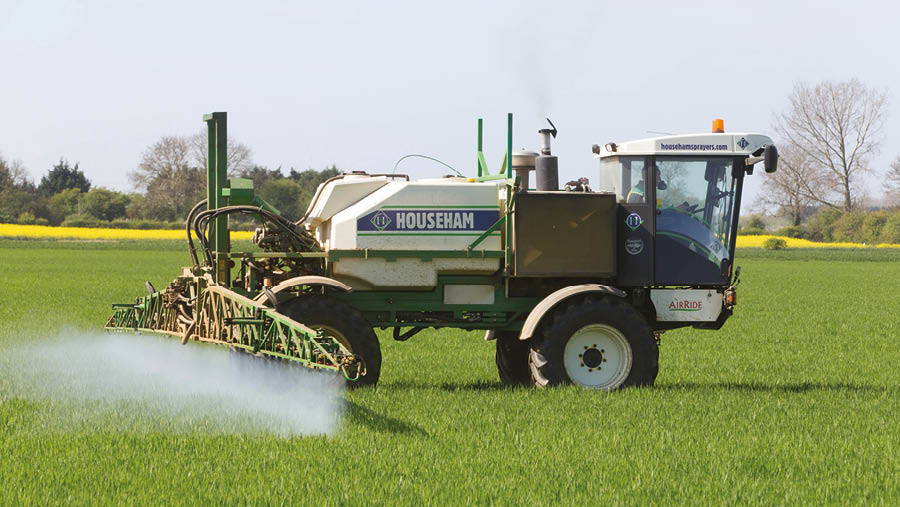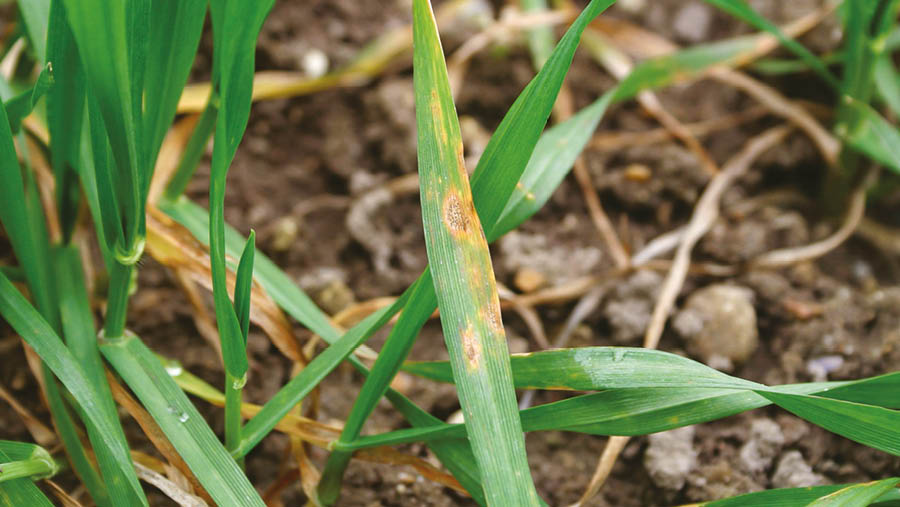Advice on septoria spread as wheat T1 fungicide timing nears
 © Tim Scrivener
© Tim Scrivener Wheat growers are being advised to focus even more on their T1 fungicide spray this season.
After a very wet March, robust rates of SDHI-mixtures are recommended as yield-damaging septoria is creeping up onto the upper leaves of crops.
See also: How a world champion keeps his wheat free of disease
With many early T0 treatments being delayed or abandoned due to the wet weather, the protection that the T1 spray brings to leaf three is vital to prevent the disease from spreading.
Fungicide expert Jonathan Blake, at crop consultant Adas, says he is seeing septoria even on wheat varieties with good resistance to the disease, due to the conducive wet conditions.
“All wheat varieties are more susceptible to septoria this year due to the mild autumn and then the very wet March,” he tells Farmers Weekly.

© Blackthorn Arable
Septoria pressure
Winter wheats drilled in mid-October, aimed at reducing the septoria pressure, are looking similar to early October sown crops due to the wet conditions seen so far this spring.
“Growers should be aiming to use one of the leading SDHI-mixtures at T1 at robust rates with a multisite fungicide, while QiI mixtures could also be used,” he adds.
Leading SDHI-azole mixtures include Revystar, Ascra and Elatus Era. Inatreq – which has a different site of action to the SDHIs and azoles and is classed as a quinone inside inhibitor (QiI) – is contained in Univoq along with an azole.
The use of Univoq last season led to damage to some sprayers with the manufacturer Corteva putting out new guidance for this season, including on water volumes, to try and avoid future damage to machinery.
Multisite use
Mr Blake suggests using a multisite, such as folpet, sulphur or mancozeb, as a protectant fungicide to help slow down the spread of septoria. However, as protectants, they do not have any systemic or curative activity.
He is seeing plenty of septoria in Herefordshire, where he is based, with leaf threes starting to emerge in early April and in need of protection.
Rust diseases have not been seen widely in his area, but are important to watch out for in yellow-rust-susceptible varieties such as Skyfall and Zyatt.
T0 sprays, usually applied in late March/early April, are normally aimed at controlling early rust diseases, but are less effective in controlling septoria at this early stage.
Active and dose rate
Aoife O’Driscoll, crop production and agronomy specialist at fellow crop consultant Niab, says there is likely to be more septoria than there has been for some seasons, making the decision on which active and dose rate to use very important.
“While dose rate should not be decided yet, active substance should and for most circumstances will be either mefentrifluconazole (Revysol) or fenpicoxamid (Inatreq),” she says.
Only later drilled varieties with very good resistance could have a different approach such as using Ascra, which will cover many bases at T1 without spending too much money, and is a cost effective option in low to moderate septoria risk varieties in low to moderate disease scenarios, adds Dr O’Driscoll.
Patrick Stephenson, regional agronomist in North Yorkshire also with Niab, is seeing lots of septoria in wheat crops. With many growers struggling to get T0 sprays onto crops, he is looking at an “upsized” T1 treatment.
His mainstay at T1 is likely to be Revystar-type products and a multisite, such as folpet, added for early drilled crops, when the wheat variety’s septoria rating is in the low 5s or below on a 1-9 scale, where a high figure shows good resistance.
“Many crops here were drilled early at about 22-23 September, so there has been a long period for septoria to develop and we are seeing a lot of disease in crops,” says Mr Stephenson.
Two products
In Scotland, the wet March and delays to T0 sprays also means the focus is very much on T1s this season. In trials conducted by crop consultant Scottish Agronomy, two fungicide products have stood out at this timing.
Scottish Agronomy managing director Adam Christie says Revystar and Univoq are “head and shoulders” above the others when leaf three is fully emerged.
Mr Christie is seeing a lot of septoria across the wide range of wheat varieties grown in Scotland, while yellow rust is largely confined to coastal areas which are prone to the disease.
“Peak infection of septoria was one week after the T1 sprays went on last year,” he says, adding that T1s were applied in the last week of April in 2022.
Last season, although the spring was dry, there was a lot of leaf wetness in Scotland. This, combined with warm weather, saw septoria cycling quickly in about two and a half weeks, putting normal spray intervals of three to four weeks under strain.
“We have not got the chemistry to chase high levels of septoria, so we have to use the best products available at T1,” he says.
His group’s programmes have focused on using Univoq at T1 and Revystar at T2, as the prothioconazole in Univoq is useful against eyespot and the water volumes advised for Univoq are easier to cope with at T1.
Key fungicide actives
- Revystar – SDHI fluxapyroxad (Xemium) + azole mefentrifluconazole (Revysol)
- Ascra – SDHIs bixafen and fluopyram + azole prothioconazole
- Elatus Era – SDHI benzovindiflupyr (Solatenol) + prothioconazole
- Univoq – Picolinamide fenpicoxamid (Inatreq) + prothioconazole
